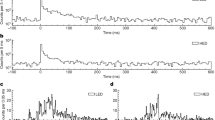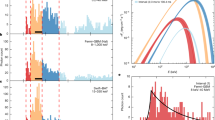Abstract
Solar flares are caused by the sudden release of magnetic energy stored near sunspots. They release 1029 to 1032 ergs of energy on a timescale of hours1. Similar flares have been observed on many stars, with larger ‘superflares’ seen on a variety of stars2,3, some of which are rapidly rotating4,5 and some of which are of ordinary solar type3,6. The small number of superflares observed on solar-type stars has hitherto precluded a detailed study of them. Here we report observations of 365 superflares, including some from slowly rotating solar-type stars, from about 83,000 stars observed over 120 days. Quasi-periodic brightness modulations observed in the solar-type stars suggest that they have much larger starspots than does the Sun. The maximum energy of the flare is not correlated with the stellar rotation period, but the data suggest that superflares occur more frequently on rapidly rotating stars. It has been proposed that hot Jupiters may be important in the generation of superflares on solar-type stars7, but none have been discovered around the stars that we have studied, indicating that hot Jupiters associated with superflares are rare.
This is a preview of subscription content, access via your institution
Access options
Subscribe to this journal
Receive 51 print issues and online access
$199.00 per year
only $3.90 per issue
Buy this article
- Purchase on Springer Link
- Instant access to full article PDF
Prices may be subject to local taxes which are calculated during checkout



Similar content being viewed by others
References
Baker, D. N. in Space Weather: The Physics Behind a Slogan (eds Scherer, K., Fichtner, H., Heber, B. & Mall, U. ) 3–20 (Lect. Notes Phys. 656, Springer, 2004)
Schaefer, B. E. Flashes from normal stars. Astrophys. J. 337, 927–933 (1989)
Schaefer, B. E., King, J. R. & Deliyannis, C. P. Superflares on ordinary solar-type stars. Astrophys. J. 529, 1026–1030 (2000)
Gershberg, R. E. Solar-Type Activity in Main-Sequence Stars 191–380 (Springer, 2005)
Shibata, K. & Yokoyama, T. A Hertzsprung-Russell-like diagram for solar/stellar flares and corona: emission measure versus temperature diagram. Astrophys. J. 577, 422–432 (2002)
Landini, M., Fossi, B. C., Pallavicini, R. & Piro, L. EXOSAT detection of an X-ray flare from the solar type star π1 UMa. Astron. Astrophys. 157, 217–222 (1986)
Rubenstein, E. P. & Schaefer, B. E. Are superflares on solar analogues caused by extrasolar planets? Astrophys. J. 529, 1031–1033 (2000)
Koch, D. G. et al. Kepler mission design, realized photometric performance, and early science. Astrophys. J. 713, L79–L86 (2010)
Brown, T. M., Latham, D. W., Everett, M. E. & Esquerdo, G. A. Kepler input catalog: photometric calibration and stellar classification. Astron. J. 142, 112 (2011)
Kretzschmar, M. The Sun as a star: observations of white-light flares. Astron. Astrophys. 530, A84 (2011)
Rodono, M. et al. Rotational modulation and flares on RS CVn and BY Dra-type stars. I - Photometry and SPOT models for BY Dra, AU Mic, AR Lac, II Peg and V 711 Tau ( = HR 1099). Astron. Astrophys. 165, 135–156 (1986)
Kopal, Z. Close Binary Systems 147–261 (Chapman & Hall, 1959)
Unno, W., Osaki, Y., Ando, H., Saio, H. & Shibahashi, H. Nonradial Oscillations of Stars 237–255 (Univ. Tokyo Press, 1989)
Debosscher, J., Blomme, J., Aerts, C. & De Ridder, J. Global stellar variability study in the field-of-view of the Kepler satellite. Astron. Astrophys. 529, A89 (2011)
Crosby, N. B., Aschwanden, M. J. & Dennis, B. R. Frequency distributions and correlations of solar X-ray flare parameters. Sol. Phys. 143, 275–299 (1993)
Shakhovskaia, N. I. Stellar flare statistics - Physical consequences. Sol. Phys. 121, 375–386 (1989)
Noyes, R. W., Hartmann, L. W., Baliunas, S. L., Duncan, D. K. & Vaughan, A. H. Rotation, convection, and magnetic activity in lower main-sequence stars. Astrophys. J. 279, 763–777 (1984)
Pallavicini, R. et al. Relations among stellar X-ray emission observed from Einstein, stellar rotation and bolometric luminosity. Astrophys. J. 248, 279–290 (1981)
Parker, E. N. Cosmical Magnetic Fields: Their Origin and Their Activity 532–749 (Oxford Univ. Press, 1979)
Randich, S. Coronal activity among open cluster stars. ASP Conf. Ser. 198, 401–410 (2000)
Skumanich, A. Time scales for CaII emission decay, rotational braking, and lithium depletion. Astrophys. J. 171, 565–567 (1972)
Barnes, S. A. On the rotational evolution of solar- and late-type stars, its magnetic origins, and the possibility of stellar gyrochronology. Astrophys. J. 586, 464–479 (2003)
Shea, M. A., Smart, D. F., McCracken, K. G., Dreschhoff, G. A. M. & Spence, H. E. Solar proton events for 450 years: the Carrington event in perspective. Adv. Space Res. 38, 232–238 (2006)
Carrington, R. C. Description of a singular appearance seen in the Sun on September 1, 1859. Mon. Not. R. Astron. Soc. 20, 13–15 (1859)
Tsurutani, B. T., Gonzalez, W. D., Lakhina, G. S. & Alex, S. The extreme magnetic storm of 1–2 September 1859. J. Geophys. Res. 108, 1268–1275 (2003)
Cuntz, M., Saar, S. H. & Musielak, Z. E. On stellar activity enhancement due to interaction with extrasolar giant planets. Astrophys. J. 533, L151–L154 (2000)
Ip, W.-H., Kopp, A. & Hu, J.-H. On the star-magnetosphere interaction of close-in exoplanets. Astrophys. J. 602, L53–L56 (2004)
Borucki, W. J. et al. Characteristics of planetary candidates observed by Kepler. II. Analysis of the first four months of data. Astrophys. J. 736, 19 (2011)
Howard, A. W. et al. Planet occurrence within 0.25 AU of solar-type stars from Kepler. Preprint at 〈http://arxiv.org/abs/1103.2541〉 (2011)
Acknowledgements
Kepler was selected as NASA’s tenth Discovery mission. Funding for the mission is provided by the NASA Science Mission Directorate. The data presented in this paper were obtained from the Multimission Archive at STScI. This work was supported by the Grant-in-Aid for the Global COE Program ‘The Next Generation of Physics, Spun from Universality and Emergence’ and the Grant-in-Aid for Young Scientists (B) from the Ministry of Education, Culture, Sports, Science and Technology of Japan. We are grateful to K. Sekiguchi and A. Hillier for suggestions.
Author information
Authors and Affiliations
Contributions
H.M. was responsible for planning, coordination and data analysis. He also wrote the majority of the text. T.S. performed the data analysis for many stellar flares observed by Kepler, and S.N. and Y.N. analysed the rotation of stars observed by Kepler. T.N. and S.K. helped with data analysis and interpretation. S.H. and D.N. contributed to the interpretation of the stellar brightness variation and helped with the data analysis from a general stellar astronomical point of view. K.S. provided theoretical interpretation of the observations and gave advice on the paper’s content.
Corresponding author
Ethics declarations
Competing interests
The authors declare no competing financial interests.
Supplementary information
Supplementary Information
This file contains Supplementary Discussion and Data, Supplementary Figures 1-8, Supplementary Table 1 and additional references. (PDF 2603 kb)
Rights and permissions
About this article
Cite this article
Maehara, H., Shibayama, T., Notsu, S. et al. Superflares on solar-type stars. Nature 485, 478–481 (2012). https://doi.org/10.1038/nature11063
Received:
Accepted:
Published:
Issue Date:
DOI: https://doi.org/10.1038/nature11063
This article is cited by
-
Circular-ribbon flares and the related activities
Reviews of Modern Plasma Physics (2024)
-
Miller’s spark
Nature Reviews Chemistry (2023)
-
Why are haematopoietic stem cells in the bone marrow: ontology recapitulates phylogeny
Leukemia (2023)
-
A study of flare emission in DV Psc using TESS data
Astrophysics and Space Science (2023)
-
Extreme Solar Events: Setting up a Paradigm
Space Science Reviews (2023)
Comments
By submitting a comment you agree to abide by our Terms and Community Guidelines. If you find something abusive or that does not comply with our terms or guidelines please flag it as inappropriate.



